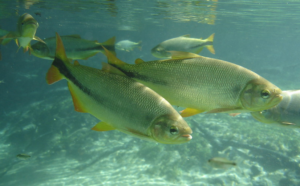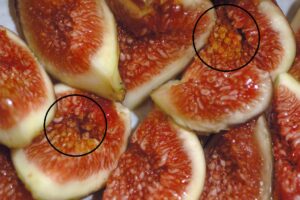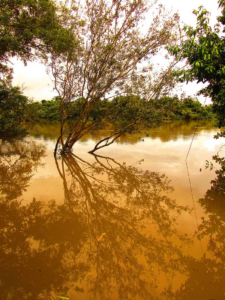Reference: Santos, João, et al. “Differential ontogenetic effects of gut passage through fish on seed germination.” Acta Oecologica 108 (2020): 103628. https://doi.org/10.1016/j.actao.2020.103628
Most of us know that trees and other plants reproduce via seeds. However, it is sometimes not enough for a seed to simply exist in order to grow into an adult tree or plant. In many cases, the seed must be eaten by an animal, processed in the digestive tract, and then leave the animal as waste in order to grow, or germinate, into a plant. This digestion process coats the seeds in enzymes, acids, and other chemicals that tell the seeds it’s time to start growing. It can also mechanically process seeds (i.e. get rid of a hard outer coating) to make it easier for them to germinate once they reach soil. Birds often aid in germination, which is unsurprising since many of us have seen birds eating small seeds. But, did you know there are many cases where fishes can perform this process as well?

One example is the fish Brycon falcatus, which frequently eats the seeds of the fig tree Ficus gomelleria. Brycon is mostly silver with a black vertical stripe on the tail, and can reach a little over a foot long. Fig seeds fall into the water, are eaten and digested by these fish, and then leave their bodies as waste. These processed seeds then germinate if the seeds make their way to adequate soil and are covered by it.
This fish-fig relationship is of particular interest because Brycon are currently threatened by habitat destruction. If these fish become extinct, this could have far reaching consequences to wider ecosystems, both aquatic and terrestrial. Researchers at the Federal University of Mato Grosso in Brazil wanted to examine this relationship between fish and fig more closely by asking a few questions: 1) are fig seeds that go through the digestive tract of Brycon actually more likely to germinate compared to seeds that have not? 2) does the size of the fish, and therefore the size of the digestive tract, affect the likelihood of germination? Quantifying this relationship allows for more targeted conservation efforts for these fish, and will allow this interesting relationship between plant and animal to continue into the future.
Fish fig feedings

In order to answer their questions, researchers collected wild Brycon fish from the Teles Pires River in Brazil. These fish were fed a meal with a fig seed, and then the waiting began for said seed to exit the fish. Fecal matter was vacuumed from the tank so seeds could be analyzed. Each fish underwent this process three times. Following the feeding trials, fish were sacrificed in order to measure the body length of the fish and the length of its intestines in order to accurately quantify size. Then, the seeds collected from the fish were planted, and growth (if any) was measured. This was compared to the growth of fig seeds that did not go through a fish’s intestines.
Did fecal figs flourish?
Overall, the seeds that passed through a fish’s intestines were over 10% more likely to germinate and begin growth into an adult fig tree. Not only were they more likely to germinate, but they tended to germinate a lot faster, about 50 days sooner on average. The average germination in this species will typically occur within 120 days, which may seem like a long time, but is perfectly normal for these figs!
Intestine length also affected the fig seeds. The longer the intestine, the less likely the seed was to germinate, with a rapid decrease in germination likelihood occurring once the intestines were longer than 10cm. The <10cm intestines also germinated seeds about 7 days quicker than all other intestine lengths.

What does this mean for figs?
The results of this study are a bit surprising given the life history of Brycon falcatus. When individuals are young (and have smaller intestines), they are typically carnivores, and only eat fruit such as fig if it’s readily available. When they are older, their diet shifts to solely fruit, and eating figs is much more commonplace. One would think that this relationship would then be that as the fish transition to a more fruit-heavy diet, they are better able to process the seeds and allow them to germinate.
Researchers suspect that as the fish become more accustomed to eating fruit and their digestive systems change, they process the fig seeds too much, causing the seeds to degrade or lose structures and compounds necessary to grow. Carnivorous young fish only eat figs on occasion, and so would not be able to process the seeds quite as thoroughly as their older counterparts.
Uncovering the details of this relationship between fish and fig is important for discussion of conserving Brazilian ecosystems, both in the water and on land, and will help to ensure these species can continue to thrive. This study also broadens our view of how plants and animals interact, providing an interesting example of how truly interconnected all life can be.
I received my PhD in Biology from Wake Forest University, and I received a BS in Biology from Cornell University. My research focuses on the terrestrial locomotion of fishes. I am particularly interested in how different fishes move differently on land, and how one fish may move differently in different environments. While I tend to study small amphibious fishes, I’ve had a lifelong fascination with all ocean animals, and sharks in particular. When not doing science, I enjoy running, attempting to bake and cook, and reading.


